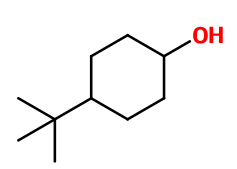
Photo credits: ScenTree SAS
Patchone®
PTBCH Alcohol (ParaTertButylCycloHexanol) ; 4-tert-butylcyclohexan-1-ol ; 4-tert-butyl cyclohexanol ; Para-tert-butyl cyclohexanol ; 4-(1,1-dimethyl ethyl) cyclohexanol ; 4-(2-methyl-2-propanyl) cyclohexanol ; Padaryl ; Patchouli hexanol

Photo credits: ScenTree SAS
Do you sell any of the raw materials? Would you like to let our users know?
Send an email to fournisseurs@scentree.coto learn about our advertising opportunities.
Do you sell any of the raw materials? Would you like to let our users know?
Send an email to fournisseurs@scentree.coto learn about our advertising opportunities.
General Presentation
-
CAS N° : 98-52-2
-
EINECS number : 202-676-4
-
FEMA number : Donnée indisponible.
-
FLAVIS number : Donnée indisponible.
-
JECFA number : Donnée indisponible.
-
Appearance : White solid
-
Density : 2,591
-
Volatility : Heart/Base
-
Price Range : €€
Physico-chemical properties
-
Molecular formula : C10H20O
-
Molecular Weight : 156,27 g/mol
-
Log P : 3,31
-
Fusion Point : 66°C
-
Boiling Point : 113°C (à 15 mmHg)
-
Detection Threshold : Donnée indisponible.
-
Optical rotation : Donnée indisponible
-
Vapor pressure : Donnée indisponible
-
Refractive Index @20°C : Donnée indisponible
-
Acid Value : Donnée indisponible.
-
Flash Point : 105°C
Uses
Uses in perfumery :
Patchone® is used in coniferous, patchouli, rose, violet notes to dry some floral notes. Also used in tea accords, patchouli reconstitutions, spring flowers notes and citrus-grapefruit notes.
Year of discovery :
1939
Natural availability :
Patchone® is not available in its natural state.
Isomerism :
Rosalva®, L-Menthol and Citronellol are among the constitutional isomers of Patchone®. Their smell is however very different, as they are not reminiscent of Patchouli EO.
Synthesis precursor :
Patchone® is not a precursor to the synthesis of another compound of olfactory interest.
Synthesis route :
Patchone® can be synthesized by a high temperature catalytic hydrogenation of para-tertbutylphenol (obtained by a Friedel-Crafts reaction on tertbutylbenzene). As the benzene ring of this molecule is stable, a high temperature is required .
Regulations & IFRA
Allergens :
This ingredient does not contain any allergen.
IFRA 51th :
This ingredient is not restricted for the 51th amendment


